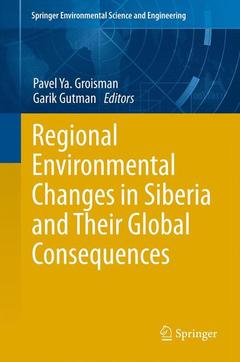Description
Regional Environmental Changes in Siberia and Their Global Consequences, 2013
Springer Environmental Science and Engineering Series
Coordinators: Groisman Pavel Ya., Gutman Garik
Language: English
Subjects for Regional Environmental Changes in Siberia and Their...:
Publication date: 09-2014
360 p. · 15.5x23.5 cm · Paperback
Publication date: 08-2012
360 p. · 15.5x23.5 cm · Hardback
Description
/li>Contents
/li>Comment
/li>
This volume presents a state-of-the-art assessment of the Earth's climate system in Siberia and relationships between climate, ecosystems and people in that region. Changes in climatic variables and land cover in Siberia are among the earliest indicators of the Earth?s response to climate warming. The volume is a compilation of results from studies on climate, land-cover and land-use changes and their interactions with biogeochemical and water cycles, atmospheric aerosol, and human and wildlife populations in Siberia. Regional changes in Siberia are predicted to affect climate and people on a global scale. NASA, the Russian Academy of Sciences, and several European institutions have supported these studies. The primary supporter of the projects that produced the results compiled in this volume is the NASA Land-Cover/Land-Use Change Program, hence most studies use remote sensing in their research. The chapters in this volume were written by an international team of scientists from the USA, Europe and Russia under the auspices of the Northern Eurasia Earth Science Partnership Initiative (NEESPI).
This book will be of interest to those involved in studying recent and ongoing changes in Siberia, be they senior scientists, early career scientists or students.
1. Introduction: Regional Features of Siberia
2. Development of Information-Computational Infrastructure for Environmental Research in Siberia as a Baseline Component of the Northern Eurasia Earth Science Partnership Initiative (NEESPI) Studies
3. Climate Changes in Siberia
4. Hydrological Changes: Historical Analysis, Contemporary Status and Future Projections
5. Effect of Climate Change on Siberian Infrastructure
6. Terrestrial Ecosystems and Their Change
7. Human Dimensions of Environmental Change in Siberia
8. Aspects of Atmospheric Pollution in Siberia
9. Summary and Outstanding Scientific Challenges for Research of Environmental Changes in Siberia
Index
Environmental and climatic changes in Siberia have been (and are projected to be) among the strongest over the Globe
Changes in Siberia have a potential for significant biogeochemical feedbacks to the Earth’s System affecting terrestrial carbon budget via permafrost-biosphere-atmosphere interactions
Some ecosystems in Siberia are fragile, showed in the past their ability for dramatic switches (e.g. from taiga into steppe/semidesert), and might move away from the state of equilibrium by intensified land use and extreme disturbances, such as fires
The region is rich in natural resources (oil, gas, minerals, and fresh water) and their sustainable exploitation requires well-informed responsible land-use practice




